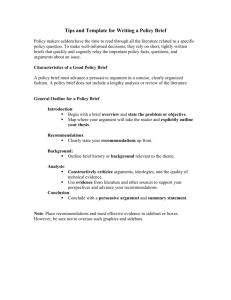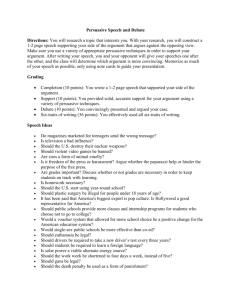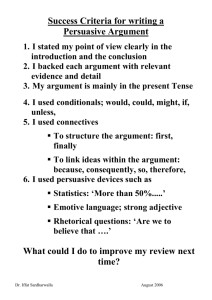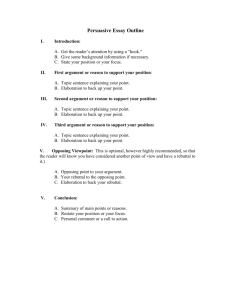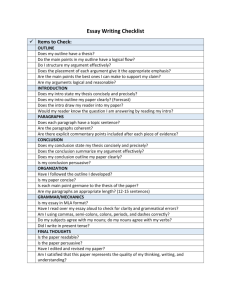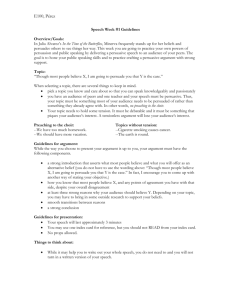Persuasive Letter Introduction
advertisement
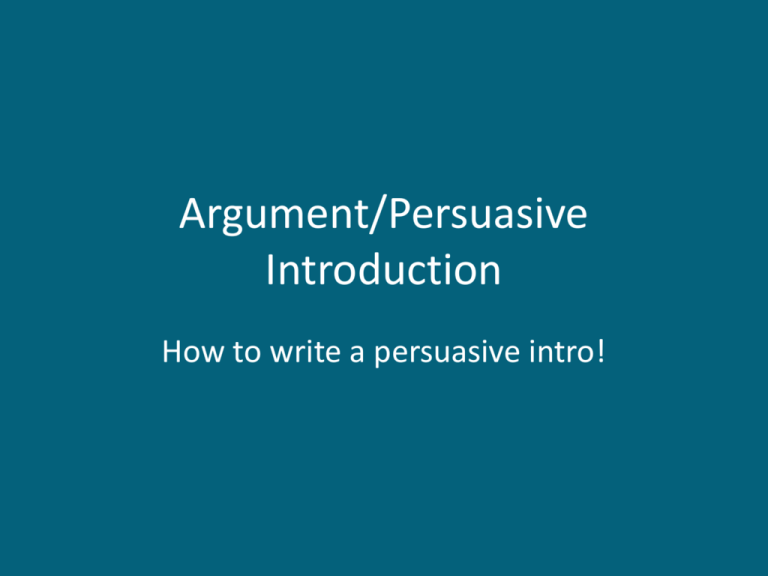
Argument/Persuasive Introduction How to write a persuasive intro! Standard ELACC8W1: Write arguments to support claims with clear reasons and relevant evidence. a. Introduce claim(s), acknowledge and distinguish the claim(s) from alternate or opposing claims, and organize the reasons and evidence logically. b. Support claim(s) with logical reasoning and relevant evidence, demonstrating an understanding of the topic or text. c. Use words, phrases, and clauses to create cohesion and clarify the relationships among claim(s), counterclaims, reasons, and evidence. d. Establish and maintain a formal style. e. Provide a concluding statement or section that follows from and supports the argument presented. What is persuasive writing? • Persuasive writing is writing for the purpose of making and supporting an argument with specific claims, reasons, examples, and details. Persuasive Expository • Makes an argument • Describes an idea for or against an idea Sample Controlling Sample Controlling Idea: My peers and I Idea: I believe that we have agreed on a plan must bring in fast food restaurants to ensure that students are purchasing lunches. of bringing in several select fast food restaurants in order to chane the way we view our food service. Important • You must select a stance and stick with it. You may not argue both sides (that changes it to a comparison/contrast expository essay) • Pick a side and stick with it What goes in the intro? • Attention Grabber: Gives your reader a reason to be interested in reading your argument • Controlling idea: shows your reader the argument you are making for or against your topic. Attention Grabber Strategies Grab your reader’s interest with: • An interesting fact • A startling statistic • A quotation • An anecdote • A scenario • A consideration • A question • A statement of wonder SOMETHING to provoke thought and interest on your topic! Controlling idea The statement or series of statements that shows your reader the argument you are making about your topic. It shows the topic and your opinion on it. Ex. I believe that our school needs a food court. You May Also… • Distinguish the claim from alternate or opposing claims OR recognize an opposing View Point • This means that you acknowledge that there are other view points, but reassure the audience that yours is the one to go along with. • This needs to happen SOMEWHERE in your paper. You may save it for the body pr conclusion if you wish Good Intro! Imagine a school with no gross cafeteria food. Students would be excited to eat every day! Instead of cafeterias, I believe that our school should have a food court. Having food courts would provide lots of great food options for students, it would decrease problems at school, and it would also increase student attendance. Good Intro! Dear Mr. Chapel, I know that you are very busy, but I would appreciate a moment of your attention. I am concerned about rumors that I have heard about our music program disappearing from school. I believe that the music program should not be cut from our school. The music program does great things for kids. DO NOT • Say: Hi, hello, hey, etc. • Say: My Name is • Say: Today I am going to talk about/today I will write about/let me tell you about/the following reasons will convince you… • Use informal register or disrespectful language • Complain • Insert erroneous details • Give away too much INEFFECTIVE INTRO Hi, my name is Hanna, and I have something to say about the dress code. It should not be so strict. I’m going to tell you the reasons why it shouldn’t. INEFFECTIVE We should be allowed to have gum in school. It would make kids pay better attention. Also do better on tests. INEFFECTIVE I think fighting is very bad. People shouldn’t do it. Here’s why. Standard ELACC8W1: Write arguments to support claims with clear reasons and relevant evidence. a. Introduce claim(s), acknowledge and distinguish the claim(s) from alternate or opposing claims, and organize the reasons and evidence logically. b. Support claim(s) with logical reasoning and relevant evidence, demonstrating an understanding of the topic or text. c. Use words, phrases, and clauses to create cohesion and clarify the relationships among claim(s), counterclaims, reasons, and evidence. d. Establish and maintain a formal style. e. Provide a concluding statement or section that follows from and supports the argument presented.

